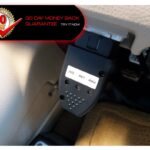For owners and enthusiasts of the BMW E39 5 Series, accessing the onboard diagnostics is a crucial part of maintenance and troubleshooting. Locating the OBD2 port is the first step in using scan tools to read error codes, diagnose engine issues, and ensure your vehicle is running smoothly. This article will guide you directly to the E39 Obd2 Location and provide context for its use in diagnosing common problems.
The OBD2 port on the BMW E39 is designed for easy access, situated inside the cabin for convenient diagnostics. Specifically, to find the e39 OBD2 location, you should look on the driver’s side of the dashboard. It is positioned at the very end of the left side, just above the driver’s side kick panel, in the area above the dead pedal. This placement is consistent across most E39 models, including the 528i mentioned in our example case, ensuring straightforward access for technicians and DIYers alike. This 16-pin connector is the standard OBDII plug used for most modern diagnostic tools.
While the OBD2 port is the primary access point for modern diagnostics, it’s worth noting that BMW E39 models, like the 1999 528i, also feature a 20-pin Data Link Connector located under the hood. This connector, found in front of the right front strut tower, was more commonly used with older diagnostic systems and for BMW-specific functions. However, for most contemporary scan tools and general OBD2 diagnostics, the 16-pin port inside the cabin is the relevant connection.
In a troubleshooting scenario, consider the case of a 1999 BMW 528i experiencing a misfire and communication issues with diagnostic tools. Despite trying multiple OBD2 scan tools on the 16-pin connector and a Mac Mentor on the 20-pin connector, communication with the DME (Digital Motor Electronics) module could not be established. Initial checks included verifying fuses and observing voltage at pin 7 of the OBDII connector, which fluctuated during scan attempts, suggesting a potential communication problem beyond just a simple connection issue. Further investigation involved scoping the CAN bus at the DME and even disconnecting the IKE (Instrument Cluster Electronics) module, which acts as a gateway, to isolate the problem. These steps, while not directly related to the OBD2 port location itself, highlight the importance of accessing this port for diagnosing deeper vehicle issues.
Ultimately, in the described scenario, the inability to communicate with the DME through either diagnostic port, after extensive troubleshooting, led to the suspicion of a faulty DME needing replacement. This example underscores that while locating the e39 OBD2 location is simple, the diagnostic journey can sometimes lead to complex system analysis to pinpoint the root cause of vehicle malfunctions. Therefore, understanding the OBD2 port’s location is just the beginning of effective vehicle diagnostics on your BMW E39.
